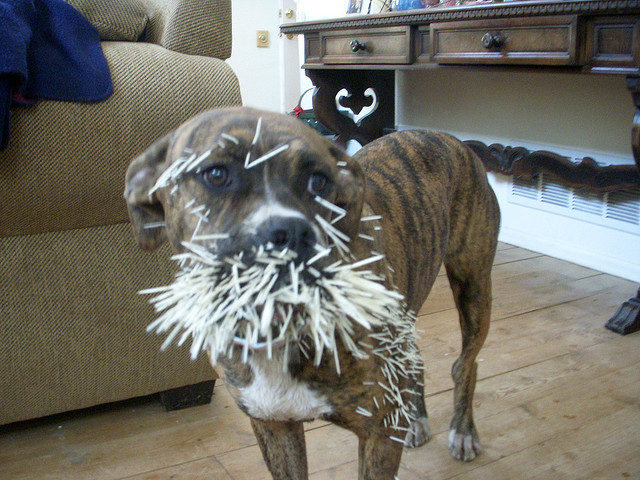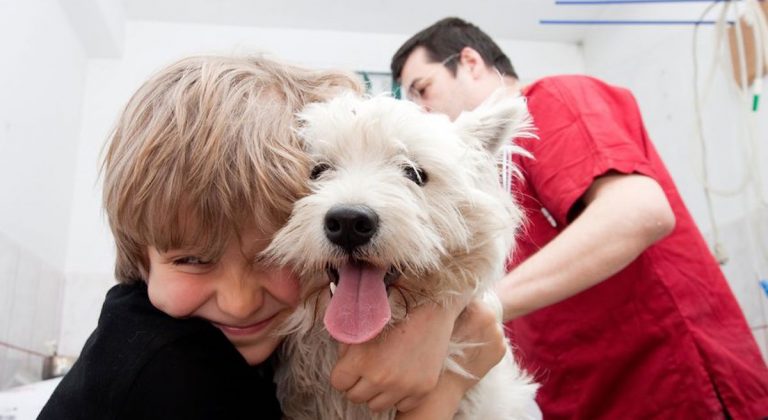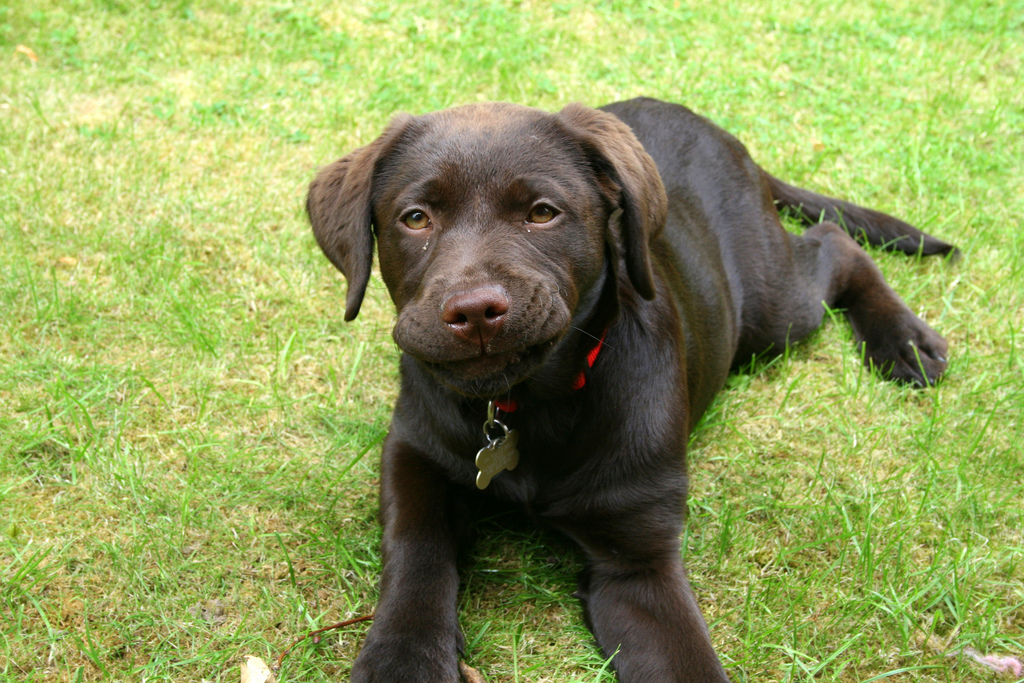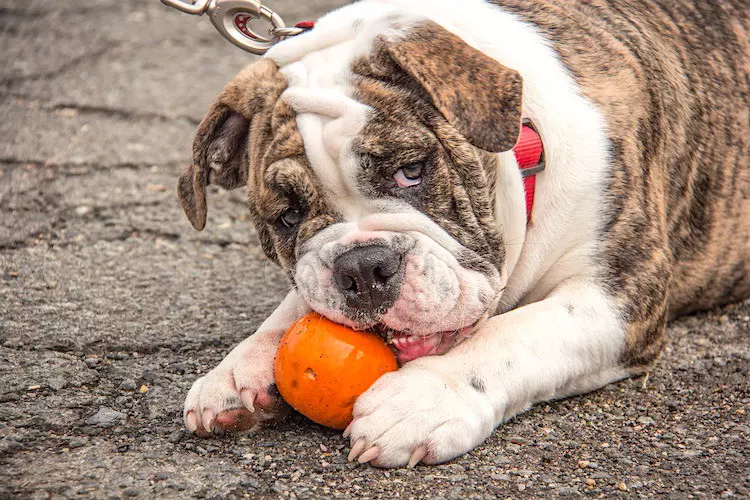The Prickly Problem With Porcupine Attacks on Dogs
The Internet has lots of bad advice about removing porcupine quills from your dog yourself. But complications are more likely to occur if you try to go DIY.

Longer, warmer days are finally here.
After long hours at the hospital, I find it’s time to relax on the deck with some lemonade and citronella candles as the sun leaves ribbons of pink and lavender above the hills.
It seems bug season comes right on the heels of the last snow melting in New England.
Dusk. People out running their dogs. Late evening walks amid the forest, the meadows — and the porcupines.
Nooo! Not quill season again! When do dogs most often get quilled by porcupines? At dawn and dusk, when the porkeys are most active. When do people have time for long walks? Before or after work or on weekends. So when do quill dogs most likely need help? On emergency, when the hospital is closed.
This is why many folks try to remove porcupine quills themselves. My quick answer? Don’t try to remove them yourself, unless there are literally just a FEW quills on a very docile dog. A few, I would say, means you can count the quills on your fingers.

Don’t leave your pet’s safety to chance
Sign up for Petful recall alerts today.

What’s in a Quill?
Porcupines, endemic in many rural areas, are members of the rodent family. They are nocturnal and are busier during the warmer months, mating and goofing off, looking for dinner.
When they get frightened — say, by a romping rollicking dog bounding close to their home turf — they get a little defensive. Turning around, they push the tail against the assailant, potentially embedding hundreds of quills into that nose that is barking up the wrong porcupine. Wild animals such as wolves, foxes, mountain lions can die of starvation if a serious quilling renders them unable to eat.
The most common area for a dog to get quilled is — duh! — in the face and the mouth. Either just rooting about in the wrong place or truly spurred on by the prey drive, dogs usually get whacked in the muzzle with the quills. Those silly enough to bite down on the poor porcupine get a MOUTHFUL of quills.
It is amazing how many dogs find this activity to be a summer sport. The woeful client will show up with their dog loaded with hundreds of quills and invariably say, “This’ll teach him, right, Doc? He won’t do this again.” They would be mistaken. I had a Jack Russell that got quilled an astounding 15 times. Honestly, I think Jack the Ripper was a member of PorcupinesMatch.com. He just kept looking for the right date.

It’s 3 a.m. Do You Know Where Your Dogs Are?
Why do some people think quills are funny? At 3 a.m. when my beeper goes off, it’s never funny.
A longtime client with Saint Bernards is on the phone. She’s laughing and, with that all-too-familiar bray of hers, tells me both of her 120-pound-plus dogs came home from night marauding with “thousands of quills.”
So are these quill dogs usually pristine examples of canine delight with some face decoration? No, quill dogs are often wet, muddy, slobbering bundles of adrenaline-pumping, porcupine-eating MANIACS! They are not easy to anesthetize, and they could be under anesthesia for hours if the quilling is serious. This is no laughing matter at 3 a.m. or any time of day.
The dogs may have some pre-existing medical conditions; they may have just eaten; they are excited and will soon realize they are in a great deal of pain. Anesthesia in an emergency situation is complicated. I don’t know why Mrs. Giantbreed finds this episode of Night Quill a sitcom. I think it’s going to be a miniseries that goes on way too long.
Not a DIY Job
Now the Internet has lots of DIY posts about how to take quills out of your own dog, and they invariably start with “Muzzle your dog.”
Muzzle a muzzle full of quills? Not happening. The muzzle of the dog is usually the worst afflicted area of the face, and a muzzle of any kind will hurt your dog and possibly break off more quills, something to be avoided at all cost.
In the hospital, we frequently have a hard time gently restraining a quill dog to give him some needed tranquilization or anesthesia without getting pricked by the quills ourselves. We almost never try to muzzle the muzzle.
Complications
The majority of quill cases are annoying, upsetting and an unplanned expense, but not serious. Quills can migrate, however, or be broken off under the skin. These cases require more veterinary care. Often, I need to make small incisions to remove embedded quills, particularly in the oral cavity.
I have found quills poking out of a dog’s conjunctiva, endangering the eye, and embedded in joints, causing serious infection and lameness. There are reports of quills migrating to the brain, piercing vital organs, entering the chest cavity, etc. These are rare, life-threatening cases. If you want to try to avoid complications, get your dog to the vet as soon as possible once you discover the quills.
Don’t Attempt This at Home
- Attempting to pull quills without anesthesia can traumatize your dog. Even the sweetest of pooches might try to bite when you come at him with tweezers or pliers for the 10th or 12th time.
- It’s much more likely that you will break off the quills or leave part of the quill in the dog when you try to do this yourself. That means you wind up bringing the dog to the vet anyway, sometimes with abscesses and hard-to-find quills.
- If you pull out say, 75% of the quills yourself, and then your dog gives you the hairy eyeball that says he’s had enough, how thrilled is he when you finally bring him in to your vet? He is traumatized, in pain and unhappy with humans. The procedure would have been easier on everyone if you had brought in the dog straight away.
- Quills are frequently in the dog’s mouth, tongue or lodged in the back of the throat. You can’t see or find these quills in the home situation. These quills can cause oral infections and pain, and should be removed as quickly as possible.
- If the quills aren’t removed fairly quickly, they can migrate further under the skin and change consistency, making them more difficult for your vet to remove.
- Leaving quills increases the risk of the dog pawing at them or rubbing them and breaking the quills.
BOTTOM LINE: Complications are more likely to occur if you try to take quills out yourself. I have had clients successfully remove five or 10 quills from a very cooperative patient. That’s all I would advise most clients try as a home project.
FUN FACT: Cats can get quilled. It is rare, but I have had at least five cats present with quills in their inquisitive little snouts.
To my repeat quill offenders, I give these few words of advice:
- Don’t let your dogs run free, particularly late at night and early morning.
- Try to have dogs off leash only under voice command, although this will not prevent all quillings.
- Nature walks are lovely, but the more “off the beaten path” you go, the more likely you are to find… WILDLIFE!
Happy summer! May your load be light and your muzzle free of quills!

This pet health content was written by a veterinarian, Dr. Debora Lichtenberg, VMD. It was reviewed for accuracy by Dr. Pippa Elliott, BVMS, MRCVS, and was last updated April 3, 2022.







